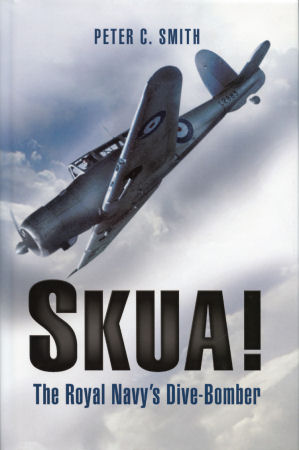
SKUA! The Royal Navy’s Dive Bomber Book Review
By David L. Veres
| Date of Review | October 2012 | Title | SKUA! The Royal Navy’s Dive Bomber |
|---|---|---|---|
| Author | Peter C. Smith | Publisher | Pen & Sword |
| Published | 2006 | ISBN | 9781844154555 |
| Format | 272 pages, hardbound | MSRP (BP) | £25.00 |
Review
The Blackburn Skua claimed several historical "firsts".
It scored Britain's first confirmed German aircraft kill of World War II. It gained distinction as the Royal Navy's first monoplane. And it was the first all-metal aircraft in Royal Navy service.
Yet it remains among the most maligned – and misunderstood – British warplanes of the conflict. Now renowned dive-bomber expert Peter C. Smith conclusively corrects the record in his superb study SKUA!.
Smith's page-turner traces the whole terrific tale in 272 pithy pages. Coverage logically begins with design and development. And initial chapters expertly examine the aircraft's torturous gestation and eventual emergence as a "two-seat dive bomber fighter ... suitable for operation as a ship plane or landplane."
Conceptions and conditions regularly teamed to compromise the concept. Forget the aircraft's surprising performance as an interceptor. HMS Ark Royal, for instance, carried just 22 Skuas of 64 total warplanes – dangerously diluting combat capacity. The Japanese Hiryu and American Yorktown, by contrast, held 73 and 96 machines, respectively.
Contents then segue to wartime use of the Skua and Roc – its hapless turreted twin. Proceeding chronologically by war zone, Smith journeys from Norway through Dunkirk to the Mediterranean – where Blackburn's progeny gained new lease on life against largely lower performing Italian and Vichy adversaries.
There they performed dive-bombing and interception missions before retiring from carrier roles in April 1941. Surviving Skuas subsequently soldiered as trainers and target-tugs. And the last – L3034 – survived with Fleet Air Arm's No.776 Squadron until March 1945.
Surprises abound. A maximum of just 33 Skuas served at any one time. Yet they claimed over 150 aerial victories in less than a year. Blackburn's battler also proved crucial in pioneering the first "Carrier Task Force" – a Royal Navy innovation during Spring 1940 Norway actions. And, lest we forget, a certain thespian – Lieutenant (A) Laurence Olivier, RNVR – flew Skuas during training efforts with No.757 Squadron.
Typos and hiccups occasionally mar this otherwise outstanding effort – most in Chapter 12, "Warmer Climes". That's "Morane" – not "Moraine". Dewoitine D.520s – not 502s – tangled with Skuas during Torch. And those "Fiat heavy bombers" were probably BR.20 mediums. An acronym glossary would have proven handy, too!
Absolutely none of this detracts from Peter Smith's terrific tome. He liberally seasons his savory Skua stew with absorbing anecdotes, official accounts, photos, tables, drawings, data and appendicies. And this vital volume remains the definitive study of Blackburn's controversial combatant.
What a ripping read. Robustly recommended!
With thanks to Pen & Sword for the review copy!







